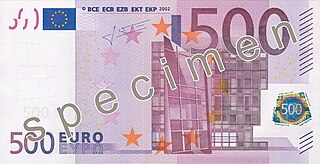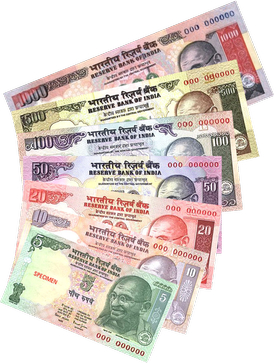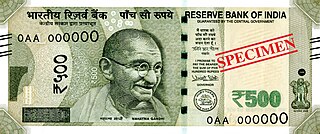
The krona is the currency of the Kingdom of Sweden. It is one of the currencies of the European Union. Both the ISO code "SEK" and currency sign "kr" are in common use for the krona; the former precedes or follows the value, the latter usually follows it but, especially in the past, it sometimes preceded the value. In English, the currency is sometimes referred to as the Swedish crown, as krona means "crown" in Swedish. The Swedish krona was the ninth-most traded currency in the world by value in April 2016.
Norwegian banknotes are circulated, in addition to Norwegian coins, with a denomination of Norwegian kroner, as standard units of currency in Norway. From 1877, after the establishment of the Scandinavian Monetary Union, Norwegian banknotes of 1000, 500, 200, 100, 50, 10 and 5 kroner have been put into circulation. The first 200 kroner banknote was first published in 1994. The others have been in use since 1877. Banknotes of 5 and 10 kroner were in use until 1963 and 1983 when they were replaced by coins.

The krone is the official currency of Denmark, Greenland, and the Faroe Islands, introduced on 1 January 1875. Both the ISO code "DKK" and currency sign "kr." are in common use; the former precedes the value, the latter in some contexts follows it. The currency is sometimes referred to as the Danish crown in English, since krone literally means crown. Krone coins have been minted in Denmark since the 17th century.

The pound sterling is the official currency of the United Kingdom, Jersey, Guernsey, the Isle of Man, British Antarctic Territory, South Georgia and the South Sandwich Islands, and Tristan da Cunha.

Banknotes of the Philippine peso are issued by the Bangko Sentral ng Pilipinas for circulation in the Philippines. The smallest amount of legal tender in wide circulation is ₱20 and the largest is ₱1000. The front side of each banknote features prominent people along with buildings, and events in the country's history while the reverse side depicts landmarks and animals.

The krone was the official currency of Austria-Hungary from 1892 until the dissolution of the empire in 1918. The subunit was one hundredth of the main unit, and was called a Heller in the Austrian and a fillér in the Hungarian part of the Empire.

The koruna, or crown, has been the currency of the Czech Republic since 1993. The koruna is one of the European Union's eight currencies, and the Czech Republic is legally bound to adopt the euro in the future.

The króna is the currency of the Faroe Islands. It is issued by Danmarks Nationalbank, the central bank of Denmark. It is not a separate currency, but is rather a local issue of banknotes denominated in the Danish krone, although Danish-issued coins are still used. Consequently, it does not have an ISO 4217 currency code and instead shares that of the Danish krone, DKK. This means that in the Faroe Islands, credit cards are charged in Danish kroner. The króna is subdivided into 100 oyru(r).

The Rwandan franc is the currency of Rwanda.
Hungarian forint paper money is part of the physical form of the current Hungarian currency, the Hungarian forint. The forint paper money consists exclusively of banknotes. During its history, denominations ranging from 10 to 20,000 forints were put into circulation in correspondence with the inflation which raised needs for higher denominations. Recently, commemorative banknotes were issued as well.
The 1997 series of Danish Banknotes are part of the physical form of Denmark's currency, the Danish Krone (kr.), issued by Danmarks Nationalbank. The 1997 series commenced in March 1997 and has since been replaced by the 2009 series.
The banknotes of Denmark, 1972 series are part of the physical form of Denmark's currency, the Krone (kr). They have been issued solely by Danmarks Nationalbank since 1 August 1818. They are still valid but are no longer printed. The theme of the notes is paintings by Jens Juel (1745–1802) of various more or less famous people on the front sides and common animals in Denmark on the back sides.

Banknotes of Scotland are the banknotes of the pound sterling that are issued by three Scottish retail banks and in circulation in Scotland. The Bank of Scotland, the oldest bank operating in the country, was the first bank in Europe to successfully print its own banknotes in 1695. The issuing of banknotes by retail banks in Scotland is subject to the Banking Act 2009, which repealed all earlier legislation under which banknote issuance was regulated, and the Scottish and Northern Ireland Banknote Regulations 2009. Currently, three retail banks are allowed to print notes for circulation in Scotland: Bank of Scotland, Royal Bank of Scotland, and Clydesdale Bank.

The five-hundred-euro note (500 €) is the highest-value euro banknote; it was produced between the introduction of the euro in 2002 until 2019. Since 27 April 2019, the banknote has no longer been issued by central banks in the euro area, but it continues to be legal tender and can be used as a means of payment. It is one of the highest-value circulating banknotes in the world, worth around 535 USD; 3 874 CNY; 83 598 JPY; 426 GBP, or 487 CHF as of April 2024. The note is used in the 26 countries that have the euro as their sole currency, with a population of about 343 million.

The ¥1,000 note is currently the lowest value yen banknote and has been used since 1945, excluding a brief period between 1946 and 1950 during the Allied occupation of Japan.

The Gandhi Series of banknotes are issued by the Reserve Bank of India (RBI) as the legal tender of Indian rupee. The series is so called because the obverse of the banknotes prominently display the portrait of Mahatma Gandhi. Since its introduction in 1996, this series replaced all Lion Capital Series banknotes issued before 1996. The Reserve Bank of India (RBI) introduced the series in 1996 with ₹10 and ₹500 banknotes.

The Indian 1000-rupee banknote is an obsolete denomination of the Indian rupee. It was first introduced by the Reserve Bank of India in 1938 under British rule and subsequently demonetized in 1946. Post-independence, the denomination was re-introduced in 1954. In January 1978, all high-denomination banknotes of ₹1000,5000, and 10000 were demonetized in order to curb unaccounted cash money.

The Indian 500-rupee banknote is a denomination of the Indian rupee. In 1987, the ₹500 note was introduced, followed by the ₹1,000 note in the year. The current ₹500 banknote, in circulation since 10 November 2016, is a part of the Mahatma Gandhi New Series. The previous banknotes of the Mahatma Gandhi Series, in circulation between October 1997 and November 2016, were demonetised on November 8, 2016.

Banknotes of the Australian pound were first issued by numerous private banks in Australia, starting with the Bank of New South Wales in 1817. Acceptance of private bank notes was not made compulsory by legal tender laws but they were widely used and accepted. The Queensland government issued treasury notes (1866–1869) and banknotes (1893–1910), which were legal tender in Queensland. The New South Wales government issued a limited series of Treasury Notes in 1893.
The Bank of Scotland £100 note is a sterling banknote. It is the largest of five banknote denominations issued by the Bank of Scotland. The current polymer note, first issued in 2022 bears the image of Walter Scott on the obverse and Flora Murray on the reverse.



















